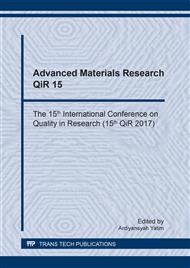[1]
Serrano, Elena, Guillermo Rus, and Javier Garcia-Martinez, Nanotechnology for Sustainable Energy, Renewable and Sustainable Energy Reviews 13 (2009): 2373-2384.
DOI: 10.1016/j.rser.2009.06.003
Google Scholar
[2]
Jiménez, Vicente, Paula Sánchez, José Antonio Díaz, José Luis Valverde, and Amaya Romero, Hydrogen Storage Capacity on Different Carbon Materials, Chemical Physics Letters 485 (2010): 152–155.
DOI: 10.1016/j.cplett.2009.12.026
Google Scholar
[3]
Niemann, Michael U., Sesha S. Srinivasan, Ayala R. Phani, Ashok Kumar, D. Yogi Goswami, and Elias K. Stefanakos, Nanomaterials for Hydrogen Storage Applications, Journal of Nanomaterials (2008): 1-9.
DOI: 10.1155/2008/950967
Google Scholar
[4]
Ahmadpour, D.D. Do, The characterization of activated carbons with oxygen and nitrogen surface groups, Carbon, 35 (12) (1997), p.1723–1732.
Google Scholar
[5]
Tsai, Wei-Tek, C. Y. Chang, and S. L. Lee, A low cost adsorbent from agricultural waste corn cob by zinc chloride activation, Bioresource Technology 64.3 (1998): 211-217.
DOI: 10.1016/s0960-8524(97)00168-5
Google Scholar
[6]
Yagmur, Emine, Meryem Ozmak, and Zeki Aktas, A novel method for production of activated carbon from waste tea by chemical activation with microwave energy, Fuel 87.15 (2008): 3278-3285.
DOI: 10.1016/j.fuel.2008.05.005
Google Scholar
[7]
Caturla, F., M. Molina-Sabio, and F. Rodriguez-Reinoso. Preparation of activated carbon by chemical activation with ZnCl2., Carbon 29.7 (1991): 999-1007.
DOI: 10.1016/0008-6223(91)90179-m
Google Scholar
[8]
Bouchelta, C., Medjram, M. S., Bertrand, O., & Bellat, J. P., Preparation and characterization of activated carbon from date stones by physical activation with steam. Journal of Analytical and Applied Pyrolysis, (2008). 82(1), 70-77.
DOI: 10.1016/j.jaap.2007.12.009
Google Scholar
[9]
Sekirifa, M. L., Hadj-Mahammed, M., Pallier, S., Baameur, L., Richard, D., & Al-Dujaili, A. H., Preparation and characterization of an activated carbon from a date stones variety by physical activation with carbon dioxide. Journal of Analytical and Applied Pyrolysis, 99, (2013).
DOI: 10.1016/j.jaap.2012.10.007
Google Scholar
[10]
Moreno-Castilla, C., Carrasco-Marı́n, F., Lopez-Ramon, M. V., & Alvarez-Merino, M. A., Chemical and physical activation of olive-mill waste water to produce activated carbons, Carbon, 39(9), (2001), 1415-1420.
DOI: 10.1016/s0008-6223(00)00268-2
Google Scholar


